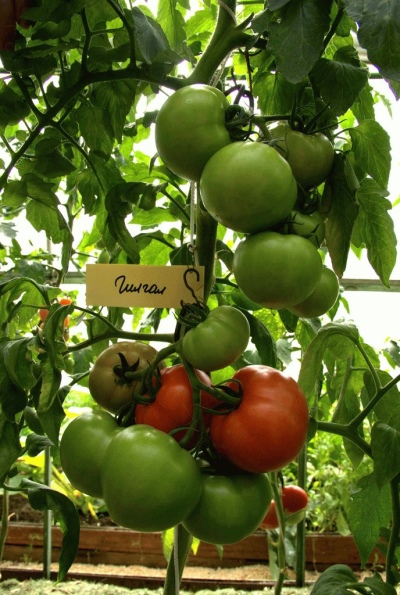
- Authors: Alekseev Y.B. (LLC "Semko-Junior")
- Year of approval: 2010
- Name synonyms: Gilgal F1
- Category: hybrid
- Growth type: indeterminate
- Appointment: fresh consumption
- Ripening period: mid-season
- Ripening time, days: 110-115
- Growing conditions: for open ground, for film greenhouses
- Marketability: high
The Gilgal tomato is quite promising for gardeners from different regions of our country. This culture has already managed to prove itself quite well. But you need to carefully study its features and characteristics, strengths and weaknesses in order to make an informed decision.
Breeding history
Gilgal was created at Semko-Junior LLC. Yu. B. Alekseev became the main breeder of the program. The plant was allowed to be used in private gardens in 2010. He has an official synonym - Gilgal F1. This designation speaks of the hybrid origin of the culture.
Description of the variety
Gilgal is a classic indeterminate tomato. Its bushes grow to a minimum of 1.8 m. Plants reaching 2.5-3 m are not so rare. The bushes themselves are quite powerful. Moderately large dark green leaves are formed on them. Tomatoes can be cultivated both outdoors and in film greenhouses; it is worth noting that it is resistant to the bronze virus, cladosporia, tobacco mosaic and verticillosis.
The main qualities of the fruit
High commercial qualities are typical for tomatoes of this variety. Therefore, it is quite possible to grow them for sale. Until the berries are ripe, they have a light green color. Fully ripe fruits with proper conditions will have a deep red color. The mass of tomatoes can be 250-300 g.
There are both simple rounded and flat-rounded specimens. The ribbing is not too pronounced in both cases. 1 brush develops from 3 to 5 tomatoes. The development of berries is typical on simple inflorescences. The first such inflorescence is laid over 6-7 leaves, then they will go through 2 or 3 leaves; it is also worth noting good keeping quality.
Taste characteristics
Most often, Gilgal tomatoes are eaten fresh. Unlike most other recent hybrids, they taste decently good. Juicy pulp displays a harmonious sweet and sour range. The aroma fully meets all the expectations of gardeners.
Ripening and fruiting
This is a common mid-season variety. Under normal cultivation conditions, it will delight the fruit in 110-115 days. It is worth noting, of course, that weather fluctuations can be reflected in this graph.
Yield
Suppliers of planting material in the official description mention the possibility of collecting 36 kg of tomatoes per 1 sq. m. For 1 bush, this corresponds to 12 kg of fruit. It is worth considering that such a result is actually achieved only with scrupulous adherence to the norms of agricultural technology. In the open field, fertility is somewhat less and is usually 16-20 kg per 1 m2. However, this level is quite worthy of attention.
The timing of planting seedlings and planting in the ground
Sowing time is usually mid-March. If it is planned to cultivate Gilgal under a film, it is planted in mid-May. If you prefer the usual garden culture, you must wait until the beginning of June. It will be possible to more accurately determine the timing only by the actual weather. The readiness of the seedlings is also necessarily evaluated - they should all get stronger.

Growing tomato seedlings is an extremely important process, because it largely depends on whether the gardener will be able to harvest at all. All aspects must be taken into account, from seedbed preparation to planting in the ground.
Landing scheme
It is allowed to place 3 plants per 1 sq. m. But it would be more correct to limit ourselves to 2 bushes. This is exactly what the most cautious gardeners do. It is recommended to adhere to the 700x400 mm system.

Growing and care
Gilgal will need to be pinned and tied up. Formation is also strictly required. In this case, the formation is carried out in both 1 and 2 stems. This tomato can withstand both cold and heat. He is not particularly afraid of temperature changes. Therefore, there are no special problems with care, even in areas of risky farming.
In the middle lane, Gilgal tomatoes are grown only in seedlings. You will have to do the same in any area with a more difficult climate. Planting technology for seedlings is similar to the handling of seeds of other varieties. Given the high growth of the bushes, it is quite reasonable to put supports already at planting. The earth is dug onto a shovel bayonet, scattering organic matter.
And also before planting, a thorough shedding of the soil is recommended. The addition of ash and superphosphate to the wells is at the discretion of the summer residents themselves. In a permanent place, the bushes are watered 1 time in 3 days using 5 liters of water. It is useful to accompany the first watering of each season with laying out mulch (straw or sawdust). Fertilizers are used three times during the growing season.




A plant needs different micronutrients at each stage of growth. All fertilizers can be divided into two groups: mineral and organic. Folk remedies are often used: iodine, yeast, bird droppings, eggshells.
It is important to observe the rate and period of feeding. This also applies to folk remedies and organic fertilizers.


Growing regions
The cultivation of Gilgal in the Volga region, the Urals and the Far East is possible without any problems. And also it is successfully grown:
in the central Black Earth region;
on the North of Russia;
in the Volga-Vyatka region;
in other parts of the Volga region;
in Siberia and the North Caucasus;
in the center of the European part of the Russian Federation.

























































































